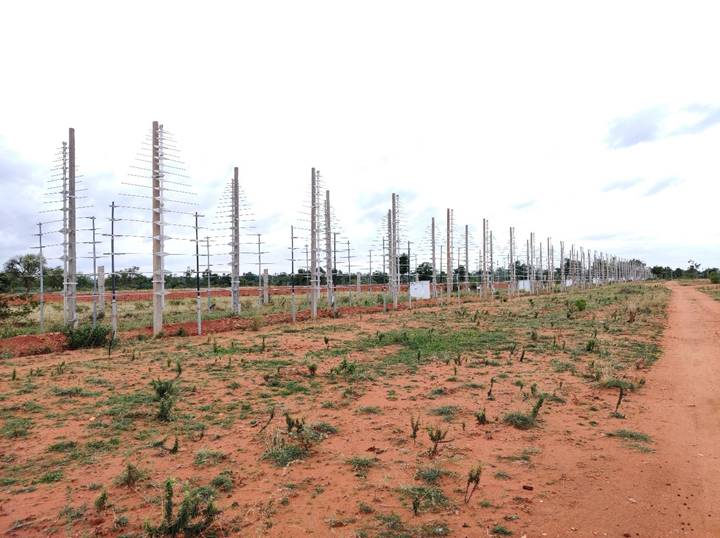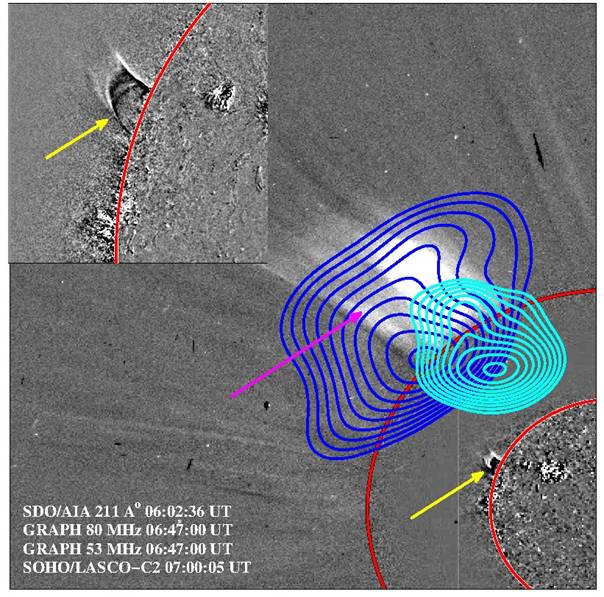
Gauribidanur, Karnataka
Indian
Scientists, along with international collaborators, have measured the magnetic field of
an eruption from the Sun's atmosphere (by observing the weak thermal radio
emission associated with the erupted plasma for the first time), offering a
rare peek to the interior of the Sun. The study of the phenomenon happening in
the Sun's atmosphere or the solar corona provides insights into the inner
workings of the Sun.
The Sun is an extremely active object, spewing out vast quantities of gas in many violent events and the corona is a region of very high temperatures, strong magnetic fields, and violent plasma eruptions. A class of such eruptions are Coronal Mass Ejections (CMEs).
CMEs are the most powerful explosions happening
in our solar system. When a really strong CME blows past the Earth, it can
damage the electronics in our satellites and disrupt radio communication
networks on Earth. Hence, astronomers regularly study these events. This field
of research helps to understand Space Weather.
 A team
of scientists from the Indian Institute of Astrophysics (IIA), an autonomous
institute of the Department of Science & Technology (DST), Government of
India, along with their collaborators, used data from their radio telescopes to
measure the magnetic field and other physical conditions of the plasma in a CME
detected on 1 May 2016. It was found with the help of radio telescopes of IIA
in Gauribidanur, Karnataka, along with some space-based telescopes that
observed the Sun in extreme ultraviolet
and white light and was caught when the base of its activity was just behind
the visible limb of the Sun.
A team
of scientists from the Indian Institute of Astrophysics (IIA), an autonomous
institute of the Department of Science & Technology (DST), Government of
India, along with their collaborators, used data from their radio telescopes to
measure the magnetic field and other physical conditions of the plasma in a CME
detected on 1 May 2016. It was found with the help of radio telescopes of IIA
in Gauribidanur, Karnataka, along with some space-based telescopes that
observed the Sun in extreme ultraviolet
and white light and was caught when the base of its activity was just behind
the visible limb of the Sun.
This allowed the researchers to detect a much weaker radio emission called thermal (or blackbody) radiation from the plume of gas that was ejected in the CME. They were also able to measure the polarisation of this emission, which is indicative of the direction in which the electric and magnetic components of the waves oscillate. Using this data, they then calculated the physical properties of the ejected plasma as well. The results of the study by R. Ramesh, A. Kumari, C. Kathiravan, D. Ketaki, and T. J. Wang have been published in the leading international journal Geophysical Research Letters.
“Though CMEs can occur anywhere on the Sun, it is primarily those which originate from regions near the centre of the visible solar surface (called the photosphere) like the one we studied that are important for us, since they may propagate directly towards the Earth,” said R. Ramesh, Professor at the Indian Institute of Astrophysics (IIA), Bangalore and the lead author of the paper. “These CMEs are usually studied in visible light, but because the disc of the Sun is so much brighter, we can detect and follow these CMEs only when they have travelled beyond the Sun's surface. However, radio observations of the thermal emission, like in our study, lets us study the CMEs right from the surface itself”, she added,” said A. Kumari, a co-author.
